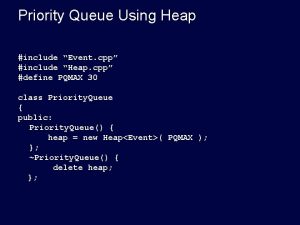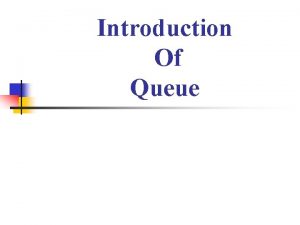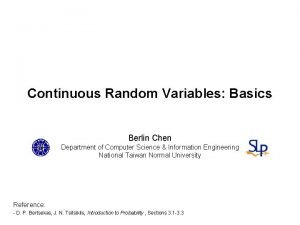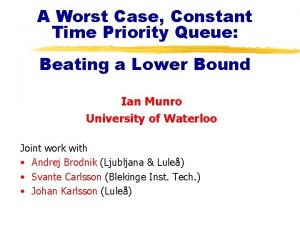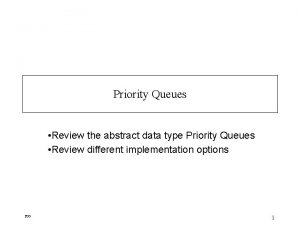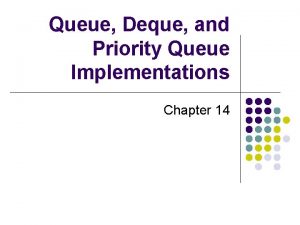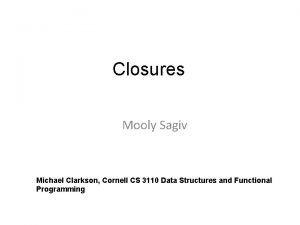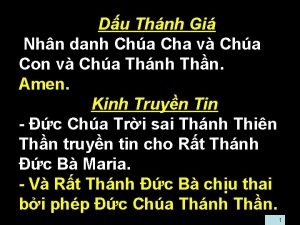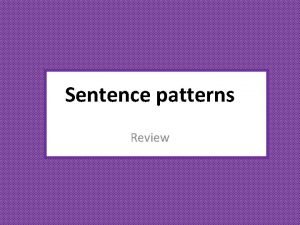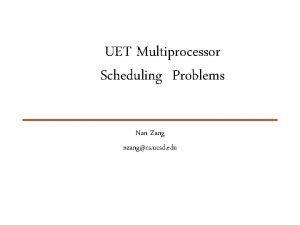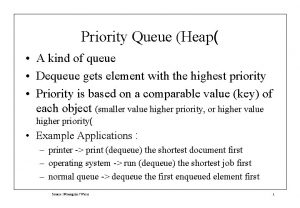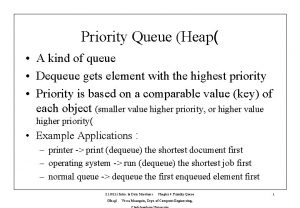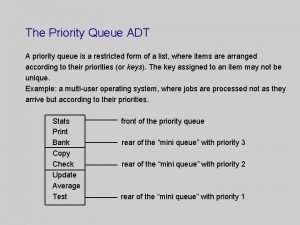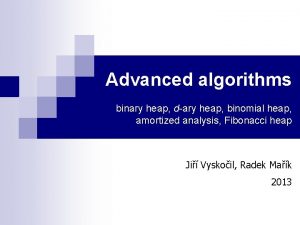Priority Queue Heap CSCI 3110 Nan Chen Priority































- Slides: 31

Priority Queue & Heap CSCI 3110 Nan Chen

Priority Queue • Data structure that stores items and restricts accesses to the highest priority item • STL (Max heap) example 3, 88 2 , 6 , 7 Delete Max ?

Applications of priority queue • Solve 0/1 Knapsack Problem (Branch and Bound ) …

Implementation of Priority Queue • Linked list: Insert O(1) , top/pop(N) • Sorted Linked list: Insert O(N) , top/pop(1) • Search Tree: Overkill (supports many operations that we don't need) and issues

Problem of Binary Search Tree Imp. • Pop( ) What if we have many items to pop from the heap Repeatedly removing a node that is in the right subtree would seem to hurt the balance of the tree by making the left subtree heavy. • The natural implementation for a priority queue is a (binary) heap

(Binary) Heaps • Structure property: Complete binary tree • (Max) Heap order property: Value of a node >= value of children (Min) Heap order property: Value of a node <= value of children

Question A: Is this a (max) heap ? Why (not) 10 8 6 50 7 4 1 5 0

Question B: Is this a (max) heap ? Why (not) 10 8 6 7 4 1 5 0

Question C: Is this a (max) heap ? Why (not) 10 8 6 2 7 4 1 5 0

Ex. Implementation of heap • Ex. Array

Ex. Implementation of min heap • Ex. Array

Index mapping between parent and childen • If the parent is the i th position in an array Left child : 2 i Right child : 2 i+1 • If child is at i th position in an array Parent : Floor ( i / 2)

Insert (inserts an item) to heap 1) Add to last index in array (resize if necessary) -> If X can be placed in the hole without violating heap order, done -> other wise (add X violates heap order , go to step 2 ) 2) Bubble up ( percolate up )

Insert 14 to min. heap 14 14

Insert 14 to min. heap

bubble. Up (min. heap) void bubble. Up(int index ) { int parent = (index -1)/2; // starting at index , while( index > 0 && array[index] < array[parent]) { swap (array[index] , array[parent]); index = parent; parent = (index -1)/2; } }

Time complexity of insertion in heap • Worst case of single insert: as much as O(log N) • Best case : O(1) • Average case : 2. 607 comparisons -> O(1) • Worst case of N inserts: as much as O(N*log N)

Pop • Top is easy, after pop , there is a “hole”at the root of the heap • When the minimum (or maximum) is removed, a hole is created at the root, swap the hole with the smaller of its children, thus pushing the hole down one level. 1) Overwrite 1 st item with the last item in the array 2) Bubble down ( percolate down )

Pop (delete. Min) -13 31

Pop (delete. Min) -13 31 31

Pop (delete. Min) -13 31

Pseudo code of bubble. Down (max. heap) void bubble. Down(int index ) { // while index is not at the last level // set child to node with the larger value // if index is smaller than child // swap index with child // else // done // update index and child }

Time complexity of bubble down • Worst case : as much as O(log N) • Average case : O(log N)

Heap is not a good choice when • Searching for random element (not minimum or maximum) • Finding an item which is not the highest priority

Build heap algorithm outline: 1) Take an (unsorted array) of values and assume that it's a complete binary tree -> Fulfils structure property requirement 2) Heapify : Call bubble. Down (percolate down) for each non-leaf node (starting at the lowest level) -> Fulfils heap-order property requirement

Two ways to build a heap • 1) Given N elements, build heap by N successive inserts Worst case -> O(N*log. N) • 2) Given N elements (assume) in a complete binary tree , What is the time complexity to turn the complete BT to a heap ? Is it possible to get better time complexity than O(N*log. N) ?

Algorithm analysis (heapbuild worst case) h: the height of tree h: # of edges on the longest downward path between that node and a leaf What is height of tree? h= ?

Observation from the binary tree Height (h) , # of bubble down ops. of each nodes Max Number of nodes at h 3=h 1 2=h-1 2 1=h-2 h-i …. . 22 2 i …. .

Ex. Summation of geometric sequence a 1=2 q=2

Ex. Summation of geometric sequence Sn=2(1 -2 n)/(1 -2)=2(2 h-1) a 1=2 q=2 S=-h+Sn=-h+2(2 h-1) and h=log. N S=-h+Sn=-h+2(2 h-1)=-log. N+2(2 log. N-1) after Canceling exponentials =log. N+2(N-1) , after ignoring lower order terms and constants =O(N)

Algorithm analysis (heapbuild worst case) • O(N) for worst-case and average-case • O(N) is better than O(N*log. N) in solution #1 , when N is large
 Priority queue using heap
Priority queue using heap Heap based priority queue
Heap based priority queue Queue introduction
Queue introduction Heap vs binary heap
Heap vs binary heap Chen chen berlin
Chen chen berlin Priority queue lower bound
Priority queue lower bound Priority queue abstract data type
Priority queue abstract data type Priority queue animation
Priority queue animation Priority queue order
Priority queue order Priority queue using avl tree
Priority queue using avl tree Deque and priority queue
Deque and priority queue Double ended priority queue
Double ended priority queue Adaptable priority queue java
Adaptable priority queue java Empty
Empty Priority queue linked list python
Priority queue linked list python Priority queue adt
Priority queue adt Min-priority queue
Min-priority queue Java priority queue example
Java priority queue example Praveen
Praveen Burman's priority list gives priority to
Burman's priority list gives priority to Priority mail vs priority mail express
Priority mail vs priority mail express Boletin 3110
Boletin 3110 Michael clarkson cornell
Michael clarkson cornell 631-828-3160
631-828-3160 What is the 8-bit unsigned binary result of 5610 − 3110?
What is the 8-bit unsigned binary result of 5610 − 3110? Pluronic rpe 2520
Pluronic rpe 2520 Chúng con cậy vì danh
Chúng con cậy vì danh Shigoto wa nan desu ka
Shigoto wa nan desu ka Nan zang
Nan zang Blue nan group
Blue nan group Nǐ jiā yǒu jǐ kǒu rén
Nǐ jiā yǒu jǐ kǒu rén Indonesia tanah air beta pusaka
Indonesia tanah air beta pusaka
